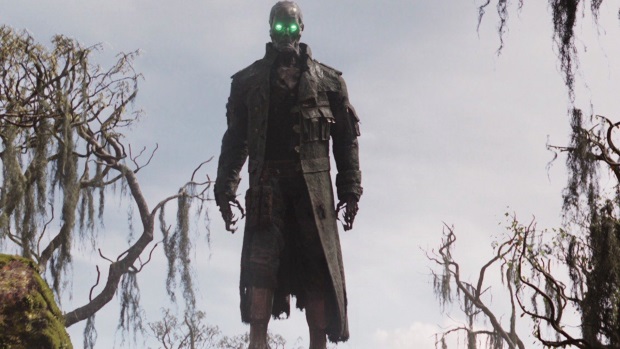Mortal Engines: Differences Between the Book and the Movie
Examining the changes – big and small – made to Philip Reeve's YA novel for the Mortal Engines movie.
This article comes from Den of Geek UK.
Expect massive spoilers for both the Mortal Engines movie and the book…
It can be a little nerve-wracking when one of your favorite books gets adapted to the big screen – there’s always a worry that some of your favourite characters, scenes or plot threads will end up on the cutting room floor, or so radically changed as to be unrecognizable.
In the case of Philip Reeve’s Mortal Engines, a sprawling YA novel that’s coming to the big screen under the guidance of Lord Of The Rings director Peter Jackson (who serves as producer on this movie), there’s a significant amount that has been altered or removed. A lot of the material that has been reduced or excised has likely been cut down to keep the film to a sensible length, but sadly while it beautifully realises many iconic locations and concepts from the book, the alterations that have been made have had the inadvertent effect of removing motivations and reducing the characterization of many characters.
Here are the most significant ways in Mortal Engines deviates from Reeve’s original novel.
Magnus Crome
Magnus Crome is the Lord Mayor of London, but he is a very different character in the original book. In the novel, he’s the head of the guild of engineers, and chooses to garb himself not in the mayor’s traditional robes of office, but in the white rubber lab coat that is his guild’s uniform. In the film, Crome is a traditionalist, who has reservations about bringing London back into the Great Hunting Ground and objects to Valentine’s plans to create and unleash MEDUSA. But the original Crome is, in fact, the driving force behind both plans, using the weapon to ensure London’s survival. In contrast to the film version, he’s a cold, ruthless and highly-intelligent leader.

Shrike’s introduction
Undead cyborg warrior Shrike is one of the few characters who makes the jump from page to screen relatively intact. One of the few differences is that when we first see him on screen, he is being kept in a mobile off-shore prison. In the novel, he’s being kept in the headquarters of the guild of engineers, and he’s not there as a prisoner. Instead, Shrike has sought out London, allowing the engineers to examine him with a view to creating more stalkers like him. In exchange for being his guinea pig, Crome promises to turn Hester into a stalker so that the two can be together.
London’s guilds
One of the more subtle differences between the book and the film is the decision not to include London’s four governing guilds: the historians, the merchants, the navigators and the engineers. Key figures from many guilds are present in the film – including Lord Mayor Magnus Crome, who in the book is the head of the guild of engineers, and Thaddeus Valentine, who Crome appoints head historian – but no mention is made of the guilds themselves.
read more: Mortal Engines Review
The historians and the engineers have significant roles in the sub-plot concerning Katherine Valentine’s investigation aboard London, but the removal isn’t particularly noticeable as this thread has been largely excised from the film. It does, however, rob us of the inclusion of additional stalkers beyond Shrike, which in turn undermines one of the major plot points in the book’s sequels.

Hester’s scar
The most noticeable difference between the book and the film is Hester’s Shaw’s trademark scar. Given to her by Valentine on the night he killed her mother, Hester’s scar is described as “hideous”, mangling her nose and mouth and even removing one of her eyes. It’s so bad, in fact, that it drives her to hide her face whenever possible. In fact, in one of the pivotal moments in the development of Hester and Tom’s relationship (which sadly also did not make the cut) he buys her a red silk shawl, which she then immediately uses to hide her scar.
The film version, however, has drastically scaled back the severity of Hester’s scar, to the point where it’s often hard to notice it. It no longer runs the length of her face, and doesn’t affect her eyes, nose or mouth. This was presumably done on the basis that it’s harder to market a film when one of its leads looks like they lost a fight with a combine harvester, but it has the effect of making the constant comments about her scar feel odd and out of place.
The Sixty Minute War
The brief but devastating conflict referred to in Mortal Engines as the Sixty Minute War is the calamity that wiped out most of the world’s population and forced people to mobilise their settlements, thousands of years before the events of the plot. In the book, it was conducted with nuclear and biological weapons, but the film takes a slightly different tack, establishing early on that ‘the Ancients’ blew themselves up not with nukes, but with quantum energy-based weapons – the same kind of weapon as MEDUSA.

Katherine Valentine
Thaddeus Valentine’s daughter Katherine is a major character in both the book and the film, but she has a significantly expanded role in the novel. For starters, the truth about Valentine’s past and about London’s development of MEDUSA is revealed through Katherine’s investigation into what happened the night Hester tried to kill her father. This investigation also leads to her forming a short-lived and rather touching relationship with Bevis Pod, an apprentice engineer. Like Katherine, Bevis also appears in the film in a reduced role.
Although in both versions Katherine is partially responsible for shutting down MEDUSA, the novel’s version of events is somewhat more dramatic. After flinging herself in front of Hester to save her from her father’s blade, Katherine collapses onto the keyboard being used to control the weapon, causing MEDUSA to malfunction and overload. In the film, she merely opens the jaws of London, allowing Tom to get inside and destroy the engine. She does, however, survive to the end of the film, whereas she dies in the book.
